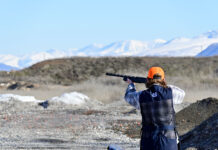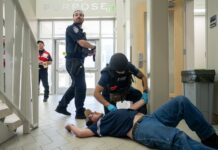This story is jointly published as part of the Utah College Media Collaborative, a historic cross-campus project bringing together emerging journalists from Salt Lake Community College, the University of Utah, Utah State University and Weber State University. The collaborative is an Amplify Utah project with support from PBS Utah.

“There are three types of people in society: sheep, sheepdogs and wolves. Every time you leave your house unarmed and untrained, you are a sheep at the mercy of the wolves.”
On a blustery Saturday in March, I heard these words in a Marriott hotel in the Salt Lake City area. Leah Call and Caitlin Keith, my colleagues from The Utah Statesman, and I were not there for vacation — or for a screening of “American Sniper,” the film that popularized the sheep-sheepdog-wolf analogy that the instructor shared — but to take a concealed firearm permit class and better understand the legal and social environment surrounding guns in our state.
Utah law
With the passage of HB0060 in 2021, Utah allows for “constitutional carry,” which means concealed carrying of a handgun, loaded or unloaded, does not require a permit.
“As long as you are at least 21 years of age or older, and you can legally possess firearms, you can carry it fully loaded,” said Jason Chapman, a concealed firearms permit supervisor at the Utah Bureau of Criminal Identification.
Although not required, a permit does come with benefits. Valid for five years after issue, it allows a buyer to forgo the $7.50 F.B.I. background check that accompanies every firearm purchase. It also authorizes gun owners to carry concealed in the 30 other states that recognize Utah permits. Provisional permits, which allow those aged 18-20 to conceal carry before they are 21, are also available.
Taking the class
The class had just over 20 people in attendance — several who looked college-age, plus some middle-aged and older adults. Though there were a few people who raised their hands and asked questions, the majority of the class was like a lecture.
Our instructor, Ben, introduced himself as a Marine and Army veteran who now works in digital security. He started the class by emphasizing four safety rules. First, he said, treat all firearms as if they are loaded. Second, never point your gun at anything you aren’t willing to destroy. Third, keep your finger off the trigger until your sights are on target. And fourth, be sure of your target and its environment.
Ben said when most people think of a situation that would involve a gun, they only think of one “battle.” In reality, he said, there are three battles: the violent encounter; the legal proceedings, both civil and criminal; and the mental and emotional toll. A significant portion of the class was dedicated to the legal side, discussing the laws surrounding gun ownership, usage and consequences according to Utah code.
Ben also reviewed how to clean a gun and the various holster options to conceal a handgun on your body. He recommended that anyone carrying concealed also have a tourniquet handy.
“Big old bag of juice here. It runs out of juice, game over,” he said, gesturing to his body. “If you’re going to carry a gun, carry the life-saving stuff, too.”
Ben said the primary causes of firearm-related incidents are ignorance, complacency and carelessness, and he commended everyone in attendance for taking the initiative to get a permit.
“In this game, what you don’t know can kill you,” he said.
According to the Bureau of Criminal Investigation, concealed firearm permit holders are responsible for learning safe handgun practices. They should have practical knowledge of the laws that govern firearms and should understand their personal abilities and limitations.
The minimum training curriculum, which all instructors must teach, is meant to provide “general familiarity,” which includes safe loading, unloading, storage and carrying of concealed firearms. It also asks that permit holders understand laws defining self-defense and use of deadly force, transportation and concealment.
While the bureau supports permit instructors including additional firearms training, like live-fire exercises, it is not required.
There was no individual instruction in our class, even with the plastic gun replicas. Ben did go over how to shoot, briefly discussing hand grip, stance, sight alignment and breath control, but it was demonstrative, not hands-on, and proportional to the rest of the content in the four-hour class, it was minimal.
Political environment
The class was rife with political commentary by the instructor. Phrases like “That’s Biden money, not real money,” and “BLM or those terrorist rioters, whoever,” were spoken as if Ben automatically assumed everyone in attendance agreed with him.
Sgt. Brady Zaugg, an investigator with the bureau, said instructors are required to cover the content in the minimum training curriculum, but as to political commentary, there are no guidelines.
“We make absolutely no mention of it,” Zaugg said. “Obviously, students do ask some of these questions, and we try to remain as neutral and impartial as possible. We make no endorsement of any kind of political party, political platform or anything like that.”
Zaugg said although instructors are licensed by the bureau, they are not employees of the state and can speak as private entities.
“We don’t specifically discourage them and say, ‘You cannot discuss certain political practices,’” Zaugg said. “If they fail to cover the minimum training curriculum, whilst they’re endorsing bad ideas, we can absolutely take action on their permit, but they are not employed by the state.”
If attendees of a class have concerns about its content or instruction, they can contact the bureau, which may choose to send someone to monitor the class.
“If we encounter bad curriculum, bad instruction, even if they cover most of the criteria — if they’re way off, then we will take corrective action as necessary, whether it’s guidance or suspension or revocation,” Zaugg said.
Ben was knowledgeable, engaging and open to questions. But he had clear partisan opinions, which my colleagues and I felt overshadowed some of the course content.
After four hours of instruction, we left more familiar with guns, holsters and Utah code, and were provided with paperwork so we could send in our permit applications immediately. However, none of us felt nearly educated enough to purchase or operate a firearm.
Ben did discuss the value in going to a gun range and trying out different models to find one that fits right, as well as practicing using a gun, but it was apparent that someone with enough confidence could acquire both a firearm and a permit without ever having to prove that they knew how to operate it safely.
Ben didn’t seem concerned about this. When we asked him if there were any barriers to his daughter carrying on campus at Utah State this upcoming fall, he shook his head no and responded proudly.
“Welcome to America.”
Maren Archibald, with contributions from Leah Call and Caitlin Keith, reported and produced this story as journalism students at Utah State University.




